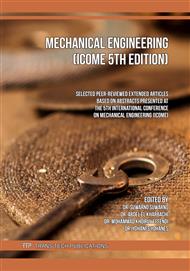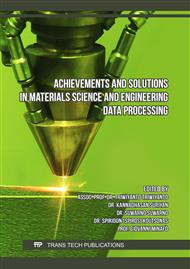[1]
K. Modi, D. Shukla, B. Bhargav, J. Devaganiya, R. Deshle, J. Dhodi, D. Patel, A. Patel, Efficacy of organic and inorganic nanofluid on thermal performance of solar water heating system, Clean. Eng. Technol. 1, (2020).
DOI: 10.1016/j.clet.2020.100020
Google Scholar
[2]
S. Rashidi, J.A. Esfahani, A. Rashidi, A review on the applications of porous materials in solar energy systems, Renew. Sustain. Energy Rev. 73 (2017) 1198–1210.
DOI: 10.1016/j.rser.2017.02.028
Google Scholar
[3]
S. Du, M.J. Li, Y. He, Z.Y. Li, Experimental and numerical study on the reflectance losses of the porous volumetric solar receiver, Sol. Energy Mater. Sol. Cells. 214 (2020) 110558.
DOI: 10.1016/j.solmat.2020.110558
Google Scholar
[4]
A.R.A. Elbar, H. Hassan, Enhancement of hybrid solar desalination system composed of solar panel and solar still by using porous material and saline water preheating, Sol. Energy. 204 (2020) 382–394.
DOI: 10.1016/j.solener.2020.04.058
Google Scholar
[5]
W. Baig, H.M. Ali, An experimental investigation of performance of a double pass solar air heater with foam aluminum thermal storage medium, Case Stud. Therm. Eng. 14 (2019) 100440.
DOI: 10.1016/j.csite.2019.100440
Google Scholar
[6]
M. Valizade, M.M. Heyhat, M. Maerefat, Experimental study of the thermal behavior of direct absorption parabolic trough collector by applying copper metal foam as volumetric solar absorption, Renew. Energy. 145 (2020) 261–269.
DOI: 10.1016/j.renene.2019.05.112
Google Scholar
[7]
H. Wang, Q. Wu, Y. Mei, L. Zhang, S. Pang, A study on exergetic performance of using porous media in the salt gradient solar pond, Appl. Therm. Eng. 136 (2018) 301–308.
DOI: 10.1016/j.applthermaleng.2018.03.025
Google Scholar
[8]
N. Prasanth, M. Sharma, R.N. Yadav, P. Jain, Designing of latent heat thermal energy storage systems using metal porous structures for storing solar energy, J. Energy Storage. 32 (2020) 101990.
DOI: 10.1016/j.est.2020.101990
Google Scholar
[9]
B. Kanimozhi, Y.N. Shinde, S.P. Bedford, K.S. Kanth, S.V. Kumar, Experimental Analysis of Solar Water Heater Using Porous Medium with Agitator, Mater. Today Proc. 16 (2019) 1204–1211.
DOI: 10.1016/j.matpr.2019.05.215
Google Scholar
[10]
S. Saedodin, A.A.H. Zamzamian, M.E. Nimvari, S. Wongwises, H.J. Jouybari, Performance evaluation of a flat-plate solar collector filled with porous metal foam: Experimental and numerical analysis, Energy Convers. Manag. 153 (2017) 278–287.
DOI: 10.1016/j.enconman.2017.09.072
Google Scholar
[11]
Z. Chen, M. Gu, D. Peng, Heat transfer performance analysis of a solar flat-plate collector with an integrated metal foam porous structure filled with paraffin, Appl. Therm. Eng. 30 (2010) 1967–(1973).
DOI: 10.1016/j.applthermaleng.2010.04.031
Google Scholar
[12]
Jalaluddin, A. Miyara, Thermal Performances of Vertical Ground Heat Exchangers in Different Conditions, J. Eng. Sci. Technol. 11 (2016) 1771–1783.
Google Scholar
[13]
Jalaluddin, R. Tarakka, A. Miyara, Performance of Shallow Borehole of spiral-Tube Ground Heat Exchanger, J. Mech. Eng. 15 (2018) 41–52.
DOI: 10.1088/1757-899x/619/1/012012
Google Scholar
[14]
Jalaluddin, A. Miyara, S. Ishikawa, R. Tarakka, A.A. Mochtar, Development of an open-loop ground source cooling system for space air conditioning system in hot climate like Indonesia, MATEC Web Conf. 204 (2018) 04007.
DOI: 10.1051/matecconf/201820404007
Google Scholar
[15]
Jalaluddin, E. Arif, R. Tarakka, Experimental Study of an SWH System with V-Shaped Plate, J. Eng. Technol Sci. 48 (2016) 11.
Google Scholar
[16]
Jalaluddin, R. Tarakka, M. Rusman, A.A. Mochtar, Performance Investigation of Solar Water Heating System with V-Shaped Absorber Plate Integrated PCM Storage. Int. J. Eng. Appl. IREA. 8 (2020).
DOI: 10.15866/irea.v8i5.18231
Google Scholar
[17]
C.C. Chen, P.C. Huang, Numerical study of heat transfer enhancement for a novel flat-plate solar water collector using metal-foam blocks. Int. J. Heat Mass Transf. 55 (2012) 6734–6756.
DOI: 10.1016/j.ijheatmasstransfer.2012.06.082
Google Scholar



